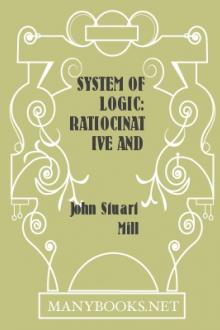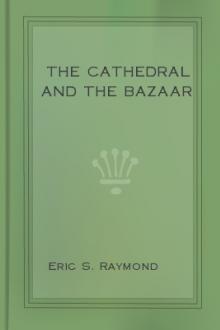A System of Logic: Ratiocinative and Inductive, John Stuart Mill [best books to read now .txt] 📗

- Author: John Stuart Mill
- Performer: -
Book online «A System of Logic: Ratiocinative and Inductive, John Stuart Mill [best books to read now .txt] 📗». Author John Stuart Mill
If the identity of the logical processes which prove particular facts and those which establish general scientific truths, required any additional confirmation, it would be sufficient to consider that in many branches of science, single facts have to be proved, as well as principles; facts as completely individual as any that are debated in a court of justice; but which are proved in the same manner as the other truths of the science, and without disturbing in any degree the homogeneity of its method. A remarkable example of this is afforded by astronomy. The individual facts on which that science grounds its most important deductions, such facts as the magnitudes of the bodies of the solar system, their distances from one another, the figure of the earth, and its rotation, are scarcely any of them accessible to our means of direct observation: they are proved indirectly, by the aid of inductions founded on other facts which we can more easily reach. For example, the distance of the moon from the earth was determined by a very circuitous process. The share which direct observation had in the work consisted in ascertaining, at one and the same instant, the zenith distances of the moon, as seen from two points very remote from one another on the earth's surface. The ascertainment of these angular distances ascertained their supplements; and since the angle at the earth's centre subtended by the distance between the two places of observation was deducible by spherical trigonometry from the latitude and longitude of those places, the angle at the moon subtended by the same line became the fourth angle of a quadrilateral of which the other three angles were known. The four angles being thus ascertained, and two sides of the quadrilateral being radii of the earth; the two remaining sides and the diagonal, or in other words, the moon's distance from the two places of observation and from the centre of the earth, could be ascertained, at least in terms of the earth's radius, from elementary theorems of geometry. At each step in this demonstration we take in a new induction, represented, in the aggregate of its results, by a general proposition.
Not only is the process by which an individual astronomical fact was thus ascertained, exactly similar to those by which the same science establishes its general truths, but also (as we have shown to be the case in all legitimate reasoning) a general proposition might have been concluded instead of a single fact. In strictness, indeed, the result of the reasoning is a general proposition; a theorem respecting the distance, not of the moon in particular, but of any inaccessible object: showing in what relation that distance stands to certain other quantities. And although the moon is almost the only heavenly body the distance of which from the earth can really be thus ascertained, this is merely owing to the accidental circumstances of the other heavenly bodies, which render them incapable of affording such data as the application of the theorem requires; for the theorem itself is as true of them as it is of the moon.[1]
We shall fall into no error, then, if in treating of Induction, we limit our attention to the establishment of general propositions. The principles and rules of Induction as directed to this end, are the principles and rules of all Induction; and the logic of Science is the universal Logic, applicable to all inquiries in which man can engage.
CHAPTER II.OF INDUCTIONS IMPROPERLY SO CALLED.
§ 1. Induction, then, is that operation of the mind, by which we infer that what we know to be true in a particular case or cases, will be true in all cases which resemble the former in certain assignable respects. In other words, Induction is the process by which we conclude that what is true of certain individuals of a class is true of the whole class, or that what is true at certain times will be true in similar circumstances at all times.
This definition excludes from the meaning of the term Induction, various logical operations, to which it is not unusual to apply that name.
Induction, as above defined, is a process of inference; it proceeds from the known to the unknown; and any operation involving no inference, any process in which what seems the conclusion is no wider than the premises from which it is drawn, does not fall within the meaning of the term. Yet in the common books of Logic we find this laid down as the most perfect, indeed the only quite perfect, form of induction. In those books, every process which sets out from a less general and terminates in a more general expression,—which admits of being stated in the form, "This and that A are B, therefore every A is B,"—is called an induction, whether anything be really concluded or not: and the induction is asserted not to be perfect, unless every single individual of the class A is included in the antecedent, or premise: that is, unless what we affirm of the class has already been ascertained to be true of every individual in it, so that the nominal conclusion is not really a conclusion, but a mere reassertion of the premises. If we were to say, All the planets shine by the sun's light, from observation of each separate planet, or All the Apostles were Jews, because this is true of Peter, Paul, John, and every other apostle,—these, and such as these, would, in the phraseology in question, be called perfect, and the only perfect, Inductions. This, however, is a totally different kind of induction from ours; it is not an inference from facts known to facts unknown, but a mere short-hand registration of facts known. The two simulated arguments which we have quoted, are not generalizations; the propositions purporting to be conclusions from them, are not really general propositions. A general proposition is one in which the predicate is affirmed or denied of an unlimited number of individuals; namely, all, whether few or many, existing or capable of existing, which possess the properties connoted by the subject of the proposition. "All men are mortal" does not mean all now living, but all men past, present, and to come. When the signification of the term is limited so as to render it a name not for any and every individual falling under a certain general description, but only for each of a number of individuals designated as such, and as it were counted off individually, the proposition, though it may be general in its language, is no general proposition, but merely that number of singular propositions, written in an abridged character. The operation may be very useful, as most forms of abridged notation are; but it is no part of the investigation of truth, though often bearing an important part in the preparation of the materials for that investigation.
As we may sum up a definite number of singular propositions in one proposition, which will be apparently, but not really, general, so we may sum up a definite number of general propositions in one proposition, which will be apparently, but not really, more general. If by a separate induction applied to every distinct species of animals, it has been established that each possesses a nervous system, and we affirm thereupon that all animals have a nervous system; this looks like a generalization, though as the conclusion merely affirms of all what has already been affirmed of each, it seems to tell us nothing but what we knew before. A distinction however must be made. If in concluding that all animals have a nervous system, we mean the same thing and no more as if we had said "all known animals," the proposition is not general, and the process by which it is arrived at is not induction. But if our meaning is that the observations made of the various species of animals have discovered to us a law of animal nature, and that we are in a condition to say that a nervous system will be found even in animals yet undiscovered, this indeed is an induction; but in this case the general proposition contains more than the sum of the special propositions from which it is inferred. The distinction is still more forcibly brought out when we consider, that if this real generalization be legitimate at all, its legitimacy probably does not require that we should have examined without exception every known species. It is the number and nature of the instances, and not their being the whole of those which happen to be known, that makes them sufficient evidence to prove a general law: while the more limited assertion, which stops at all known animals, cannot be made unless we have rigorously verified it in every species. In like manner (to return to a former example) we might have inferred, not that all the planets, but that all planets, shine by reflected light: the former is no induction; the latter is an induction, and a bad one, being disproved by the case of double stars—self-luminous bodies which are properly planets, since they revolve round a centre.
§ 2. There are several processes used in mathematics which require to be distinguished from Induction, being not unfrequently called by that name, and being so far similar to Induction properly so called, that the propositions they lead to are really general propositions. For example, when we have proved with respect to the circle, that a straight line cannot meet it in more than two points, and when the same thing has been successively proved of the ellipse, the parabola, and the hyperbola, it may be laid down as an universal property of the sections of the cone. The distinction drawn in the two previous examples can have no place here, there being no difference between all known sections of the cone and all sections, since a cone demonstrably cannot be intersected by a plane except in one of these four lines. It would be difficult, therefore, to refuse to the proposition arrived at, the name of a generalization, since there is no room for any generalization beyond it. But there is no induction, because there is no inference: the conclusion is a mere summing up of what was asserted in the various propositions from which it is drawn. A case somewhat, though not altogether, similar, is the proof of a geometrical theorem by means of a diagram. Whether the diagram be on paper or only in the imagination, the demonstration (as formerly observed[2]) does not prove directly the general theorem; it proves only that





Comments (0)